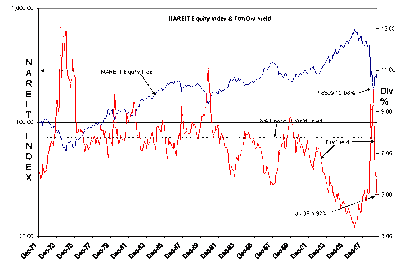Davidson” submits:
With the 2007’s Total Mortgage level over $14.5Trillion of which more than $11.1Trillion were home mortgages it would be hard to find a stronger connection to the financial system than this. Data from US Census Bureau most current information.
Equity REITs are publicly traded investment vehicles which use mortgage debt in the purchase of investment properties and form the REIT asset class that is used as part of your balanced portfolio. The market capitalization of the Equity NAREIT holdings has grown from 1972’s year end $332Mil to 2007’s year end $288.7Bil. This ~870 fold increase results from a combination of growth and increasing holdings from 12 REITs at inception and to 118 REITs at the end of 2007. Data from http://www.reit.com. At the end of 2008 the Equity NAREIT market capitalization had fallen to $176.2Bil. A comparison of the NAREIT Total Return vs Equity Indices in Chart 1 makes clear that ~94% of returns are derived from dividends which in turn by law are 90% of FFO(Funds From Operations).
Chart 2 of the NAREIT Equity Index vs. Ttm(Trailing12mos) Dividend Yield shows that the dividend yield which had held in the 6%-9% for much of the period fell almost to ~3% in 2007 during a period of low cost mtg funding. The subsequent correction of 2008-2009 forced dividend yields to 10.08% in Feb09 which was at a historically high level and was a signal that the Return/Risk had become attractive. The recent fall in dividend yield to July ‘09’s 4.92% is a function of recent changes in the tax law that currently permit REITs to issue stock in lieu of cash which increases their financial flexibility. This change is expected to be a temporary forbearance, a bridge during the current economic period. Most expect regular 90% dividends to be paid in cash once this difficult environment has moderated.
My view is that these dividends will return although it is difficult to predict their timing and their magnitude till there is greater clarity. I continue to recommend REITs as an attractive allocation in balanced portfolios with a strong preference for Global REIT exposure.
Disclosure (“none” means no position):

